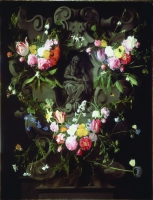ERASMUS QUELLINUS II and
DANIEL SEGHERS, S.
J.
Flemish,
1590-1661 and 1607-78
A Garland
of Flowers with the Education of the
Virgin,
c. 1645
Oil on canvas
Worcester Art Museum, Worcester,
Massachusetts
Eliza S. Paine Fund
in memory of W. and F. Paine, 1966.37
|
 |
By the 1600s, many
parts of northern Europe were well supplied with Jesuits. The Flemish city of
Antwerp, in the Spanish Netherlands, was a wealthy port and trading center, as
well as a vibrant center for printing and the arts.
Seghers entered
the Jesuit novitiate in 1614, and took his final vows as a Jesuit brother in
1625. Though he did not seek ordination as a priest, Seghers lived in Jesuit
communities as a brother, and continued his work as a painter. He came to be
known especially as a painter of flowers and still life. In the Worcester Art
Museum’s painting by Quellinus and Seghers, Quellinus painted the central
portion, as a grisaille (shades of gray to resemble a sculpture) of the
education of the Virgin Mary by her mother Saint Anne. Paintings of the Madonna
and Child surrounded with a garland of flowers were a theme that had been
developed by Jan Brueghel, Seghers’ teacher.
It is Seghers,
the Jesuit, not Quellinus, who painted what one might think of as the more
secular part of the work. But was a floral garland seen as ‘secular’
in circles influenced by the Society of Jesus?
Both the theme of
Mary—whether as mother of Jesus or as a student—and the theme of a
floral garland echoed the spirituality and pastoral priorities of the Society
of Jesus. In the culminating meditation of his Spiritual Exercises, on
God’s love, Ignatius speaks of how God dwells in creation, including in
plants and animals. Ignatius invites those undertaking his Spiritual Exercises
to pay attention to such created things, and to consider how God’s love is
manifested in and through them. Seghers’ work as a flower painter would in
no way have contradicted his vocation as a Jesuit; such loving attention to
floral beauty was central to his way of living out Ignatian spirituality.
Jesuits in the
seventeenth century imagined Mary as a model for all Catholics to follow. The
Society of Jesus founded so-called Marian congregations in most places where
Jesuits worked; these congregations were organizations of laypeople formed by
the Spiritual Exercises, often students and graduates of Jesuit schools, along
with other persons attracted to Jesuit spirituality. In these congregations,
devotion to Mary was linked with works of charity such as visiting the sick and
feeding the hungry.